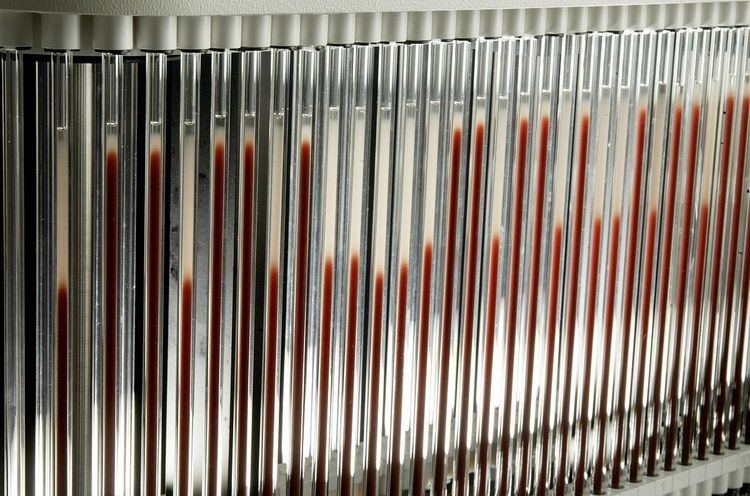 | ||
Synonyms sedimentation rate, Westergren ESR | ||
The erythrocyte sedimentation rate (ESR) is the rate at which red blood cells sediment in a period of one hour. It is a common hematology test, and is a non-specific measure of inflammation. To perform the test, anticoagulated blood was traditionally placed in an upright tube, known as a Westergren tube, and the rate at which the red blood cells fall was measured and reported in mm/h.
Contents
- Diagnosis
- Disease severity
- Monitoring response to therapy
- Normal values
- Adults
- Children
- Relation to C reactive protein
- History
- Research
- References
Since the introduction of automated analyzers into the clinical laboratory, the ESR test has been automatically performed.
The ESR is governed by the balance between pro-sedimentation factors, mainly fibrinogen, and those factors resisting sedimentation, namely the negative charge of the erythrocytes (zeta potential). When an inflammatory process is present, the high proportion of fibrinogen in the blood causes red blood cells to stick to each other. The red cells form stacks called 'rouleaux,' which settle faster, due to their increased density. Rouleaux formation can also occur in association with some lymphoproliferative disorders in which one or more immunoglobulins are secreted in high amounts. Rouleaux formation can, however, be a normal physiological finding in horses, cats, and pigs.
The ESR is increased in inflammation, pregnancy, anemia, autoimmune disorders (such as rheumatoid arthritis and lupus), infections, some kidney diseases and some cancers (such as lymphoma and multiple myeloma). The ESR is decreased in polycythemia, hyperviscosity, sickle cell anemia, leukemia, low plasma protein (due to liver or kidney disease) and congestive heart failure. The basal ESR is slightly higher in females.
Diagnosis
It can sometimes be useful in diagnosing some diseases, such as multiple myeloma, temporal arteritis, polymyalgia rheumatica, various auto-immune diseases, systemic lupus erythematosus, rheumatoid arthritis, inflammatory bowel disease and chronic kidney diseases. In many of these cases, the ESR may exceed 100 mm/hour.
It is commonly used for a differential diagnosis for Kawasaki's disease (from Takayasu's arteritis; which would have a markedly elevated ESR) and it may be increased in some chronic infective conditions like tuberculosis and infective endocarditis. It is also elevated in subacute thyroiditis also known as DeQuervain's.
Stages in erythrocyte sedimentation:
There are 3 stages in erythrocyte sedimentation
1) Stage 1 : Rouleaux formation - First 10 minutes
2) Stage 2 : Sedimentation or settling stage - 40 mins
3) Stage 3 : Packing stage - 10 minutes (sedimentation slows and cells start to pack at the bottom of the tube)
Disease severity
It is a component of the PCDAI (Pediatric Crohn's Disease Activity Index), an index for assessment of severity of inflammatory bowel disease in children.
Monitoring response to therapy
The clinical usefulness of ESR is limited to monitoring the response to therapy in certain inflammatory diseases such as temporal arteritis, polymyalgia rheumatica and rheumatoid arthritis. It can also be used as a crude measure of response in Hodgkin's lymphoma. Additionally, ESR levels are used to define one of the several possible adverse prognostic factors in the staging of Hodgkin's lymphoma.
Normal values
Note: mm/h. = millimeters per hour.
Westergren's original normal values (men 3 mm and women 7 mm) made no allowance for a person's age. In 1967 it was confirmed that ESR values tend to rise with age and to be generally higher in women. Values are increased in states of anemia, and in black populations.
Adults
The widely used rule calculating normal maximum ESR values in adults (98% confidence limit) is given by a formula devised in 1983:
This formula is no longer credited. Other studies show only a small dependence of ESR on age and much lower values, as seen in the following:
ESR reference ranges from a large 1996 study of 3,910 healthy adults:
Children
Normal values of ESR have been quoted as 1 to 2 mm/h at birth, rising to 4 mm/h 8 days after delivery, and then to 17 mm/h by day 14.
Typical normal ranges quoted are:
Relation to C-reactive protein
C-reactive protein is an acute phase protein produced by the liver during an inflammatory reaction. Since C-reactive protein levels in the blood rise more quickly after the inflammatory or infective process begins, ESR is often replaced with C-reactive protein measurement. There are specific drawbacks, however: for example, both tests for ESR and CRP were found to be independently associated with a diagnosis of acute maxillary sinusitis so in some cases the combination of the two measurements may improve diagnostic sensitivity and specificity. Several studies investigated the differential diagnostic values of ESR and CRP in inflammatory disease, and concluded ESR is a potential meaningful biomarker for disease differentiation.
History
The test was invented in 1897 by the Polish pathologist Edmund Biernacki. In some parts of the world the test continues to be referred to as Biernacki's Reaction (Polish: odczyn Biernackiego, OB). In 1918 the Swedish pathologist Robert Sanno Fåhræus declared the same and, along with Alf Vilhelm Albertsson Westergren, are eponymously remembered for the Fåhræus-Westergren test (abbreviated as FW test; in the UK, usually termed Westergren test), which uses sodium citrate-anti-coagulated specimens.
Research
According to a study released in 2015, a stop gain mutation in HBB gene (p. Gln40stop) was shown to be associated with ESR values in Sardinian population. The red blood cell count, whose values are inversely related to ESR, is affected in carriers of this SNP. This mutation is almost exclusive of the inhabitants of Sardinia and is a common cause of beta thalassemia.
